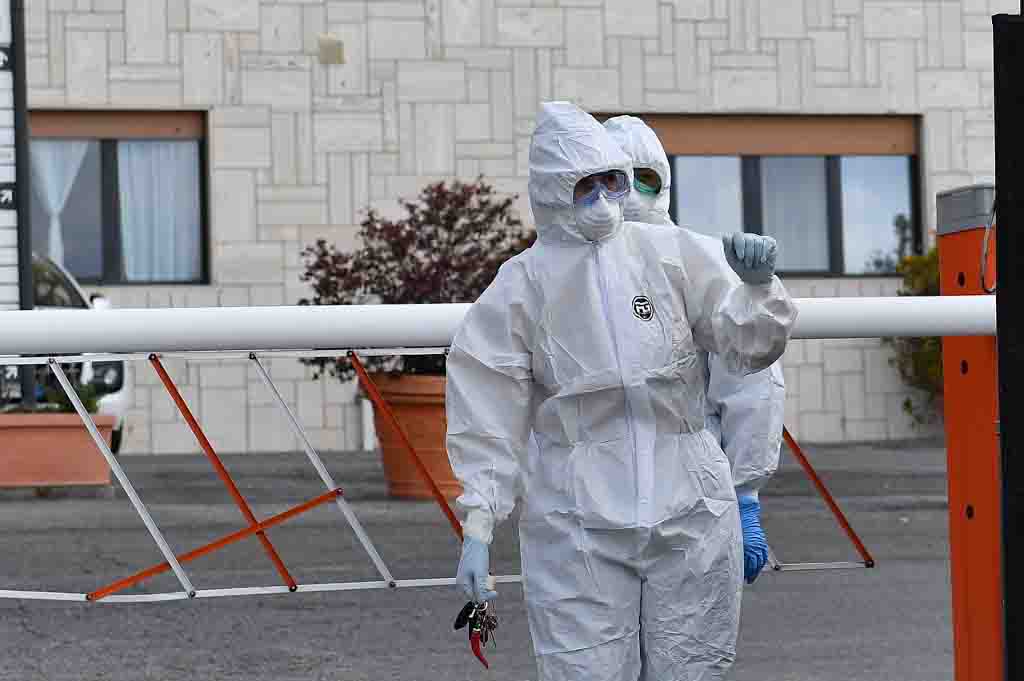

Italian PM Conte demands more financial aid from Europe as shutdown continues
Italian Prime Minister Giuseppe Conte on Friday called for the EU to show “more ambition, more unity and more courage” as he continued to push for more financial help in dealing with the coronavirus crisis.
He continued a war of words with EU Commission chief Ursula von der Leyen via the pages of an Italian newspaper on Friday.
“Dear Ursula,” he wrote in a letter to La Repubblica, “I hear ideas (from you) not worthy of Europe. The decisions we make today will be remembered for years.”
In diretta ora: https://t.co/ZMO8g5tqdT https://t.co/emSQAXNqO4
— Giuseppe Conte (@GiuseppeConteIT) March 31, 2020
His words were in response to a letter from von der Leyen in the same paper on Thursday, where she had promised more support for Italy.
Conte wants the whole bloc to share the financial burden of fighting the outbreak by issuing billions of euros in so-called “coronabonds”, helping Italy to borrow more cheaply to fight the pandemic that has killed nearly 14,000 people and shattered the country’s economy.
Von der Leyen has sided with Germany and some other northern European countries, who argue that pooled risk could raise their borrowing costs.
She prefers an EU-wide guarantee that could raise 100 billion euros ($108 billion) for the specific purpose of helping national unemployment schemes.

Female doctors wearing a protective mask and overalls stand at the entrance of the Nomentana hospital in Fonte Nuova – Tor Lupara, near Rome, on April 2, 2020 during the country’s lockdown aimed at curbing the spread of the COVID-19 infection, caused by the novel coronavirus. (Photo by Tiziana FABI / AFP)
Conte said he “welcomed” the EU’s initiative but made it clear that he still wanted the coronabonds.
“When fighting a war, you must do everything possible to win and equip yourself with all the tools needed for the reconstruction,” Conte wrote.
This required “innovative tools such as the European Recovery Bonds”.
He said the bonds were “useful to finance the extraordinary efforts that Europe will have to put in place” and “are in no way aimed at sharing the debt that each of our countries has inherited from the past”.
‘Nothing ruled out’
EU leaders failed to find a common response last week and gave their finance ministers until next Thursday to agree on something useful.
Von der Leyen’s Latvian deputy Valdis Dombrovskis told La Repubblica newspaper Friday that nothing was being ruled out.
“We are open to every option,” Dombrovskis wrote. “We need an ambitious, coordinated and effective response.”
Italy’s toll from the new disease reached 13,915 on Thursday, more than any other country.
Its current lockdown to stop the spread has been extended through mid-April, and at least some measures are expected to continue beyond that.
With most businesses shut down, Italy’s economy is expected to suffer its biggest shock since World War II.
While the nationwide lockdown measures imposed on March 12th seem to be helping to contain the outbreak, this has also caused serious economic problems for a country where poverty was already rife.
Millions of people in Italy are now thought to be out of work, with many left without the money for food and essentials.
Civil protection service chief Angelo Borrelli told RAI television Friday that Italians would probably “have to stay at home for many more weeks”.Conte is preparing a new economic response package after pledging 25 billion euros in assistance to affected families and businesses last month.
His proposals reportedly include guaranteed loans that could theoretically deliver up to 500 billion euros to struggling companies and households.
This would expand the 340 billion euros in guarantees announced last month.
Italy’s coronavirus deaths up slightly amid hope cases are peaking
There have now been almost 14,000 coronavirus victims in Italy, officials said on Thursday, while infections seem to have reached a peak in some areas.
Another 4,668 cases of the new coronavirus were confirmed on Thursday, according to the latest daily figures from Italy’s Civil Protection department.
In total, Italy has now confirmed 115,242 cases of coronavirus since the outbreak began, including deceased and recovered patients.
The death toll figure rose by 760, a slight rise compared to Wednesday’s 727.
This brings the total number of fatalities to 13,915.
Of those originally infected, some 18,278 in total had fully recovered on Thursday, compared to 16,847 the day before.
There were 4,053 people in intensive care, up from a previous 4,035, however authorities said the total number of patients in hospital because of the virus was down.
“The number of people being hospitalized has decreased,” said Angelo Borrelli, the head of the Civil Protection Department, who himself recently tested negative for coronavrus after falling ill.
“61 percent of the total infected people are in home isolation with no symptoms or with mild symptoms, a number that has increased in percentage terms,” he said.
The infection rate has also slowed again in Lombardy, the worst-affected region, with 1,292 new cases registered on Thursday, compared to 1,565 on Wednesday.
The death toll has not fluctuated dramatically for a few days, though some doubts were raised on Wednesday about the accuracy of data on fatalities.
Authorities acknowledge that the data are incomplete because deaths from COVID-19 related causes outside hospitals are not counted.
Italy has registered more deaths than anywhere else in the world, and currently accounts for around 28 percent of all global fatalities from the virus.
The world is watching closely for evidence that Italy’s coronavirus quarantine measures have been enough to contain the spread.
Borrelli said on April 1st that infection rates in some parts of the country were reaching a peak, but said “the south is still at risk.”
“It would be a mistake to let our guard down now,” he added.
The Italian government on Wednesday extended the country’s current lockdown measures until April 13th.
In a speech on Wednesday night, Italian prime minister Giuseppe Conte told the public any loosening of the measures could spark a new rise in the number of cases.
“If we started to loosen the measures, all of our efforts would have been in vain and we would pay a very high price,” he said.
He also warned he could not commit to when the lockdown would end.
“The moment the data is consolidated and the experts give their response, we’ll be able to identify an end date. But I can’t give it today.”
Explained: Five reasons why the coronavirus hit Italy so hard
The new coronavirus found dangerously fertile ground in Italy’s demographics, business, geography and culture, writes Italian researcher Sara Belligoni.Italy is one of the nations worst hit by the global coronavirus pandemic. As a scholar in the field of security and emergency management who has studied and worked in Italy, I have determined that there are at least five major reasons why the country is suffering so much.
1. Lots of old people
Italians have the sixth-longest life expectancy in the world – 84 years old. That means lots of Italians are elderly: in 2018, 22.6 percent of its population was 65 or over, among the highest proportions in Europe.
Medical researchers have said the coronavirus poses a more serious threat to older people than to younger ones. Older people are more likely to contract the COVID-19 disease and, mostly, to have a more severe case of it. That can also increase the demand for hospitals’ intensive-care units.
Many older Italians may have been also exposed to the virus in the workplace; in 2019 the average Italian retirement age was expected to be 67, at least two years later than average retirees in other Western developed nations.
2. Close proximity
Italians aren’t used to social distancing. They are very physically affectionate people: hugs and cheek-kisses are common not just among family members but also friends and even work colleagues.
Even when they’re just chatting, Italians are closer together than many other people, because their culture’s psychological perception of personal space is smaller than in other countries.
Large social gatherings, formerly common in public areas, were banned by Italian Prime Minister Giuseppe Conte at the beginning of March 2020.
3. Dense population
There isn’t a lot of space in Italy for people to spread out in. Italy is a densely populated country, with an average density of 533 people per square mile. In comparison, Germany has a population density of 235 people per square mile while the US has 94.
Two-thirds of Italians live in urban areas that are even more dense. Rome has 5,800 people per square mile, and Milan packs more than 19,000 people into every square mile. That’s almost twice the density of Berlin and Washington, DC.
4. Northern Italy is a business hub
Milan, in northern Italy, is the country’s financial capital, and has close trade and educational connections with China. The whole region of northern Italy is home to offices for many multinational corporations.
Workers travel from all over the world to attend meetings and conventions in northern Italy. An infected person not only could infect others, but those people could rapidly spread out across the entire country.
5. Massive number of cases
With far fewer people, Italy’s infection rate is much higher than China’s. No other country has a truly comparable set of circumstances.
A key factor in emergency management is learning lessons from others in similar circumstances – but there is no one for Italy to learn from at this stage of the crisis. Chinese experts have traveled to Italy to help – but many of the lessons they are bringing only became clear after Italy’s outbreak began, so the Italians are behind where other countries, with more recent outbreaks, may be.
The Italian government has progressively worked to contain the disease, including declaring a total national lockdown on March 10. More than two weeks later, the country may finally be seeing a decline in the number of new cases.
Italy has struggled – and is continuing to fight – against an unprecedented crisis that found dangerously fertile ground in elements of the country’s demographics, business, geography and culture.
But its people haven’t lost their social habits – just adapted them, and created perhaps a temporary new national motto: “Distanti ma uniti.”
Distant, but united.
The Author is Sara Belligoni, Ph.D. Student in Security Studies, University of Central Florida


















